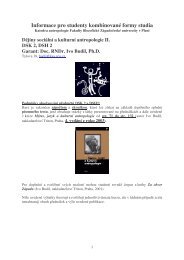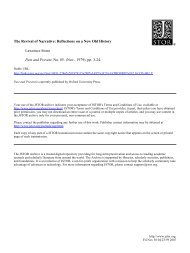BOB SCRIBNER Historical Anthropology of Early Modern Europe
BOB SCRIBNER Historical Anthropology of Early Modern Europe
BOB SCRIBNER Historical Anthropology of Early Modern Europe
You also want an ePaper? Increase the reach of your titles
YUMPU automatically turns print PDFs into web optimized ePapers that Google loves.
28 Bob Scribnersimple-minded person she purported to be before her inquisitors, simplywriting down what she was told by her confessor. Rather we have theimpression <strong>of</strong> a shrewd and street-wise young woman, who knew exactlyhow to play up to a gender stereotype that would deflect responsibilityfrom herself. So effective was her strategy that the investigation was indefinitelyprolonged, her guards were won over and even the Inquisitorcompromised, and finally she escaped with a relatively light punishment.Even the historian, provided with all the copious documents <strong>of</strong> the case,cannot determine her true role behind the strategic disguise 34 . Inquisitorsand judges were certainly wily men <strong>of</strong> some worldly experience and theywere <strong>of</strong>ten able to read behind courtroom strategies, as Michael Weisserpointed out many years ago in discussing peasant litigation for slander inthe villages <strong>of</strong> the Monies. Yet in some circumstances the inquisitor maystill be as uninformed as the anthropologist. Indeed, the most assiduousinvestigator, Jean de Coras, the magistrate <strong>of</strong> the Parlement <strong>of</strong> Toulousewho popularised the case <strong>of</strong> Martin Guerre, was still unable to enlightenus about Bertrande de Rols' motives in accepting an imposter into herhome and bed 35 . The best way forward in such cases may involve notseeking out some dispassionate observer who may serve as an early modernsurrogate for the ethno-historian. Rather, we could employ the awareness<strong>of</strong> contemporary anthropology that the anthropologist is always indialogue with his or her subjects, and that it is this very dialogue thatconstitutes the hermeneutic possibilities <strong>of</strong> the encounter with anotherculture. That is, just as the anthropologist may have to be content withchronicling a culture responding to his or her intrusions, the ethno-historianmay have to be content to focus on points <strong>of</strong> encounter where twomentalities or worlds meet, the <strong>of</strong>ficial and the in<strong>of</strong>ficial, the clerical andthe lay, the urban and the rural, providing only a refracted image <strong>of</strong> thesubordinate culture.One <strong>of</strong> the most challenging departures in these debates over the methods<strong>of</strong> historical anthropology has been a recent contribution by GananathObeyesekere, in part a reply to Marshall Sahlins' fascinating essay <strong>of</strong>1985 on the death <strong>of</strong> James Cook. Sahlins reorientated our thinking about34 Richard L. Kagan, Lucretia's Dreams. Politics and Prophecy in Sixteenth CenturySpain (Berkeley, 1990).35 M. Weisser, The Peasants <strong>of</strong> the Monies (Chicago, 1972), 101 - 112; N. Z. Davis,The Return <strong>of</strong> Martin Guerre (Cambridge, Mass., 1983).







